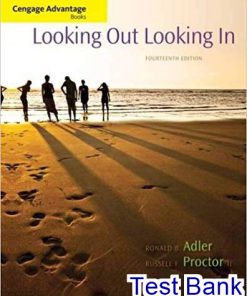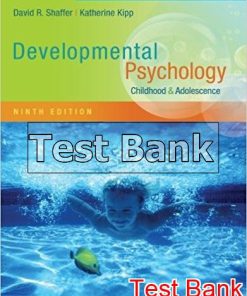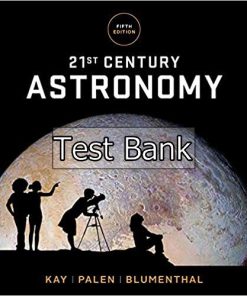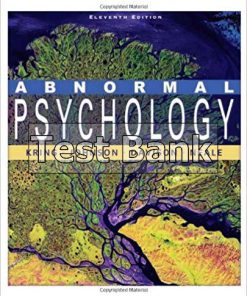Looking Forward Through The Lifespan Developmental Psychology 6th Edition Peterson Test Bank
$26.99$50.00 (-46%)
Looking Forward Through The Lifespan Developmental Psychology 6th Edition Peterson Test Bank.
You may also like
Looking Forward Through The Lifespan Developmental Psychology 6th Edition Peterson Test Bank
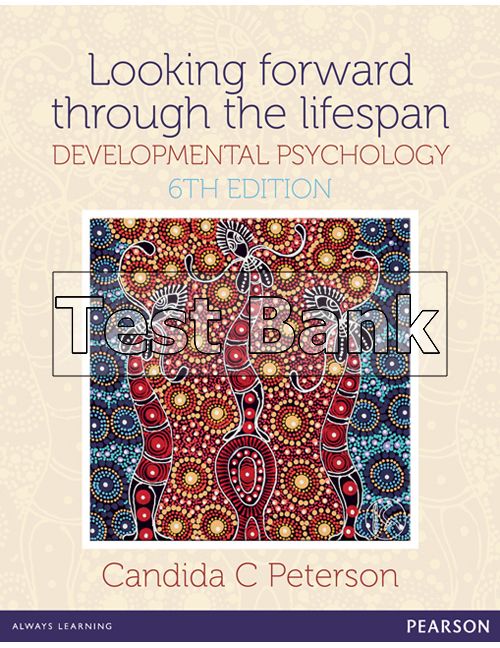
Product details:
- ISBN-10 : 1442556501
- ISBN-13 : 978-1442556508
- Author: Candida Peterson, PhD, F.A.S.S.A
When a local context really makes the difference…
The edition of this original Australian text continues to offer the most balanced coverage of theory and research for Australian students and educators and appeals to students from many backgrounds. It covers the domains of development including neurological, cognitive, social, physical and personality.
The text is organised chronologically by chapter. Within each chapter content is organised topically. This structure allows for a degree of flexibility and lecturers can choose the way they wish to approach the content, whether it is topically or chronologically.
Table contents:
- Part 1 Studying human development over the lifespan
- Overview
- Chapter 1 Lifespan developmental psychology
- Chapter overview
- Adults can grow psychologically through the whole of life
- Hallmarks of the lifespan approach to psychological understanding
- Lifelong development
- Continuity and change
- Box 1.1 Four luminary lifespans
- Culture and the lifespan
- Normative lifespan transitions
- Why is age so important to psychologists?
- The personal meaning of age
- Box 1.2 A case in point: What it means to be 50
- Personal plans for lifespan development
- The human lifespan today
- Social and historical changes in personal age consciousness
- Box 1.3 Activity suggestion: Lifeline drawing
- Will you live to be 100?
- Culture, age and lifespan development
- Filial piety and attitudes to age
- Indigenous ageing: Becoming an elder
- Development in historical perspective
- The history of childhood
- The history of adolescence
- The history of adulthood, old age and the lifespan
- Age and society
- The normative social clock
- Box 1.4 Activity suggestion: Age makes the news
- The problem of ageism
- Box 1.5 A pause for thought: Is it wrong to laugh?
- Box 1.6 How can you explain it?: Ageism is a health hazard
- The science of lifespan human development
- Studying change
- The field of lifespan developmental psychology
- Core assumptions of the lifespan approach
- The concept of development
- Permanent change
- Qualitative and quantitative change
- Normative, generalisable change
- Box 1.7 Activity suggestion: Development through art
- Progressive change: The actualising of hidden potential
- Life-cycle surprises
- Longitudinal studies with unexpected twists
- Box 1.8 How can you explain it?: Cheerfulness, conscientiousness and longevity
- The adult development of ‘late bloomers’
- Nurturing development through the lifespan
- Developmental optimisation
- Box 1.9 A case in point: Optimising health education with traditional Indigenous art
- Parents and developmental optimisation
- Optimisation through education
- The optimising roles of health and helping professionals
- Looking forward
- Chapter summary
- For further interest
- Chapter 2 The science of lifespan development: Goals, theories and methodology
- Chapter overview
- The scientific goals of lifespan research
- Three key scientific goals
- Box 2.1 Activity suggestion: What can research tell us that we don’t already know?
- Descriptive research: Picturing psychological development age by age
- Interpreting descriptive age norms
- Explanatory research: Creating theories and testing predictions
- Box 2.2 How can you explain it?: Age differences in IQ
- Box 2.3 Activity suggestion: Test your sleuthing skill
- Analogies for development: Pre-theoretical models
- The environmental-mechanistic model
- The organic-maturational model
- Box 2.4 Using science: From description to explanation: Why do we age?
- The dialectical model
- Box 2.5 Activity suggestion: Test your taste for the dialectical model of development
- Optimisation: The goal of applied research
- Life-cycle surprises and optimisation research
- The methods of developmental psychology
- Box 2.6 How can you explain it?: Learning music in childhood boosts mental ability in old age
- Case studies
- Naturalistic observation
- Box 2.7 A child called Louise
- Experimental research in developmental science
- Self-report techniques
- Developmental research designs: Tracking psychological functioning over time
- The cross-sectional design
- Box 2.8 How can you explain it?: Are Australians becoming more temperamental?
- The longitudinal design
- Time-lag studies and time-of-test effects
- Sequential methodologies
- Theories of lifespan development
- The psychoanalytic approach: Freud and Erikson
- Freud’s theory
- Box 2.9 Freud’s life
- Erikson’s theory
- Box 2.10 Erikson’s life
- The cognitive-developmental approach: Piaget and Vygotsky
- Piaget’s theory
- Box 2.11 Piaget’s life
- Vygotsky’s theory
- Box 2.12 Vygotsky’s life
- Learning theories: Classical theories and the social learning approach
- Social learning and Bandura’s social-cognitive learning theory
- Box 2.13 A glossary of learning terminology
- Adult-oriented lifespan theories: Organic self-determination
- Buhler’s theory
- Box 2.14 Buhler’s life
- Levinson’s theory
- Vaillant’s theory
- Paul Baltes’ cognitive lifespan theory
- Selective optimisation with compensation
- Box 2.15 Baltes’ life
- Chapter summary
- For further interest
- Chapter 3 In the beginning: Heredity, prenatal development and birth
- Chapter overview
- The first step in development: Heredity meets environment
- Genes, chromosomes and DNA
- Genes and individual differences
- Polygenic inheritance versus simple pairs of genes
- Dominance–recessivity in a gene pair
- Co-dominance and additive gene effects
- Sex-linked traits
- Chromosome abnormalities
- Genetic counselling
- The new genetics: Polygenic inheritance and quantitative methodologies
- Polygenic inheritance
- Genome-wide association studies
- Gene–environment interdependence
- Epigenesis and epigenetics
- Nurturant parenting reshapes DNA
- Epigenetic shaping of the human brain
- Behaviour genetics
- Twin studies: A window on nature versus nurture
- Twin comparisons: Intelligence and personality
- Thinking critically about twin studies
- Identical twins: Identical treatment?
- Box 3.1 How can you explain it?: Uncanny similarities
- Shared and non-shared environment
- The children-of-twins (CoT) design
- Studying polygenic inheritance with the adoption design
- Adoption studies of intelligence and personality
- Combining adoption studies with twin studies in cross-cultural research
- Thinking critically about adoption designs
- Effects of adoption itself on psychological development
- Nature and nurture together: The interaction between heredity and environment
- Box 3.2 Fountain-of-youth in one world, poison chalice in another
- Box 3.3 Expressing individuality: A ‘whole’ child of six
- Niche-picking: Children as active environmental engineers
- Non-shared family environments
- Heritable environments: Active and passive gene–environment correlations
- The range-of-reaction principle
- Evolutionary preselection and specialisation
- Box 3.4 Activity suggestion: Bush tucker
- Why are children in the same family so different? Resolving the paradox of nature versus nurture
- Heredity’s lifespan influence
- Delayed gene action
- Gene–environment interactions in adult development
- Prenatal development: From zygote to foetus
- The period of the zygote
- The period of the embryo
- The period of the foetus
- Foetal brain development
- Cortical cell migration
- Prenatal myelination
- The emergence of behaviour
- Box 3.5 How can you explain it?: Does the nervous system ‘age’ before birth?
- Critical periods in prenatal development
- Teratogenic influences
- Optimising prenatal development
- Box 3.6 Optimising development: The ecology of the womb
- Box 3.7 How can you explain it?: Maternal stress
- Prenatal cognitive development
- The human mind before birth
- The expectant parents during pregnancy
- Planned and unplanned pregnancies
- Expecting a boy or a girl
- Box 3.8 How can you explain it?: Life-cycle surprises: Does a mother’s attitude to the foetus pred
- The baby’s birth
- Stages of labour
- The uncomplicated delivery
- Childbirth complications: Prematurity and low birth weight
- Box 3.9 Indigenous insight: Birth in a traditional Aboriginal community
- Long-term developmental consequences of birth complications
- The transition to parenthood
- Box 3.10 A child called Louise: A father’s reaction to childbirth
- Chapter summary
- For further interest
- Part 2 Infancy—From birth to age two
- Overview
- Chapter 4 Infancy: Physical, neurobiological, sensorimotor and cognitive development
- Chapter overview
- Behaviour in the first three months
- Reflex behaviours
- Crying
- Culture and caregivers’ responses to crying
- Soothing the crying infant
- Indigenous Australians’ soothing practices
- Sleeping
- Lifespan changes in dreaming
- Box 4.1 Indigenous insight: Dreamtime lullabies
- A child called Louise: Pleasures and dreams at 10 months of age
- Culture and infant sleep patterns
- Box 4.3 How can you explain it?: Cot death: The mystery killer
- Box 4.4 Optimising development: Reducing SIDS via neurocognition and learning
- Solitary sleep versus communal social inclusion
- Neurobiological and neurocognitive development in infancy
- Growth of the brain
- Neurogenesis and neural network connections
- Synapses: Generating and pruning
- Myelination
- Physical growth during infancy
- Cultural influences on physical growth: Aboriginal children
- Box 4.5 How can you explain it?: Does owning a TV slow down the body’s physical growth
- The growth of beauty
- The development of motor skills
- Nature versus nurture in motor skill development
- Box 4.6 A case in point: The motor skills of a one-year-old
- Culture and skill: Aboriginal infants’ motor development
- The development of sensory and perceptual skills
- The five senses at birth
- The development of vision and hearing during infancy
- Perceptual development
- Coordinating perceptual and motor skills
- Cognition and learning during infancy
- Learning complex contingencies
- Curiosity and attention
- Box 4.7 The world of a 16-month-old
- Infant learning
- Piaget’s sensorimotor stage: Concepts of permanence and causality
- Box 4.8 Activity suggestion: Grabbing attention over the lifespan
- The concept of object permanence
- The concept of causality
- Contemporary research on infants’ causality concepts
- Personality, emotion and cognition
- Gaining trust
- Box 4.9 A case in point: Babies learn about blindfolds by being tricked
- Developing a sense of personal control
- Learned helplessness
- Developing self-efficacy
- Chapter summary
- For further interest
- Chapter 5 Infancy: Social, emotional and personality development
- Chapter overview
- The roots of personality: Infant temperament
- All babies are different
- Box 5.1 Expressing individuality: Two different babies
- Patterns of temperament
- Nature versus nurture: Genetic and neurocognitive influences on temperament
- Box 5.2 How can you explain it?: Prickly Generation X?
- Variations in temperament over cultures and generations
- Indigenous Australian infants’ temperaments
- Box 5.3 Indigenous insight: Breastfeeding
- Seeking causes for cross-cultural differences in temperament: Genes versus childrearing
- Indigenous parenting and personality
- Box 5.4 How can you explain it?: Cultural paradoxes in early temperament
- Lifespan perspectives on temperament
- Does early temperament predict later personality?
- The goodness-of-fit hypothesis
- Temperament, parenting and the socialisation process
- Emotional development in infancy
- Emotional self-regulation
- Attachment: The first intimate relationship
- Box 5.5 A case in point: Pacifying temper with a thumb
- Before attachment: General sociability
- Prerequisites for attachment
- First signs of true love
- The ‘Strange Situation’
- Box 5.6 How can you explain it?: Do you cuddle a teddy bear?
- Cultural variations in attachment classifications
- The cognitive and neurocognitive underpinnings of secure attachment: Working models and modules
- Optimising development: Causes and consequences of secure/insecure attachment
- Caregiver sensitivity
- The caregiver’s attachment history
- Infant temperament and attachment
- Day care and attachment
- Box 5.7 A case in point: Day care—a brave new world
- Attachment through the lifespan
- Child and adult sequels to infant attachment
- Box 5.8 A pause for thought: Can you typecast these six-year-old storytellers?
- Friendships with other children as a function of infant attachment
- Attachment and intimacy over the lifespan
- Fathering
- Father–infant attachment
- Culture, fathering and the world of work
- Fathering from a lifespan perspective
- Chapter summary
- For further interest
- In a nutshell: Milestones of development in infancy
- Part 3 The preschool period—From age two to age six
- Overview
- Chapter 6 Toddlers: Cognitive, social and personality development in the context of language acquisi
- Chapter overview
- Getting ready to speak: The cognitive, social and neurological prerequisites for language
- Symbolic representation
- Sign language and spoken words
- The neuropsychology of sign language and the developing brain
- Symbolic representation and pretend play
- Language milestones: Speech sounds before meaning
- Box 6.1 Activity suggestion: Let’s pretend
- Producing noises
- Listening to others’ speech
- Pragmatic language and pseudo-conversations
- The greatest discovery in life: Word meaning
- Box 6.2 A case in point: Ba’ means ‘ball’
- Culture, cognition and the growth of word meaning
- Linguistic creativity: Overextension of word meaning
- Underextension of word meaning
- Box 6.3 Indigenous insight: Thinking about numbers in Anindilyakwa and Walpiri
- Language development: Is it uniquely human?
- Box 6.4 A case in point: The range of things that a word can mean
- Culture and conversational partners as language teachers
- Setbacks in vocabulary development
- Bilingual children
- Box 6.5 A pause for thought: Can you decode the toddler’s lexicon?
- Syntactic development: Mastering the rules of language
- The holophrastic stage
- Box 6.6 What can a single word mean?
- Two-word sentences
- Telegraphic grammar and overregularisation
- Transformational grammar: Negatives, queries and complex sentences
- Box 6.7 A case in point: The magic of a child’s early sentence constructions
- Theories of language acquisition
- Is language innate?
- Conversational ‘nurture’ theories of language development
- Pragmatic skills and the growth of social language
- Language, culture and social cognition
- Conversations, culture and motherese
- Indigenous language teachers and learners
- Box 6.8 Indigenous insight: Adults teaching language to children
- Social cognition and conversation
- Raising the ante and listening sympathetically
- Box 6.9 Indigenous insight: Motherese in Arnhem Land
- Personality development in toddlerhood
- Self-awareness
- Erikson’s lifespan theory: Autonomy versus shame and doubt
- Toddlerhood negativism: Nexus of social, personality and language development
- Negativistic self-assertion
- Day care and negativism
- Box 6.10 A case in point: The terrible twos
- Gaining social skills: Negativism and negotiation
- Cultural differences in parenting for self-assertion
- Box 6.11 Activity suggestion: Developing assertiveness
- Neuroscience and lifespan language growth
- Neuroscience and language learning
- Critical periods in language growth
- The lifespan benefits of bilingualism
- Bilingualism among Indigenous Australians and New Zealanders
- Box 6.12 Indigenous insight: Test yourself: Developmental stages
- Chapter summary
- For further interest
- Chapter 7 Preschoolers: Physical, neurocognitive, emotional, intellectual and social development
- Chapter overview
- Physical growth and motor skills during early childhood
- Physical growth
- Diet, growth and health
- Motor skills
- Box 7.1 Indigenous insight: Bush tucker
- Neurocognitive development during the preschool period
- Brain growth
- Myelination of neural paths
- Lateralisation
- Deafness and brain lateralisation
- Brain plasticity and critical periods for language
- Cognitive development: Preoperational thinking
- Preoperational concepts of biology and physics
- Box 7.2 A case in point: Animistic thinking
- Preschool logic
- The problem of conservation
- Box 7.3 Piaget’s realism and artificialism
- Conservation of distance
- Conservation of number
- Conservation of substance
- Conservation of fluid quantity
- The development of conservation understanding
- Box 7.4 Activity suggestion: Joking with conservation
- Numerical and mathematical concepts
- Classification
- Seriation
- Transitive inference
- Numeracy
- Piaget’s theory: Mechanisms of developmental change
- Equilibration
- Cognitive conflict
- Responding to Piaget: Contemporary extensions and alternatives
- Social influences on cognitive development: Peer discussion and conflict
- Culture, peer debate and cognitive development
- Learning to interpret conserving transformations
- Lessons from bilingual children
- Box 7.5 Indigenous insight: Thinking in two languages at once
- Conversational biases in experimental testing
- Vygotsky’s sociocultural approach
- Memory development
- Box 7.6 Applying psychology: Memories in court
- Strategic memorisation by preschoolers and older children
- Box 7.7 A case in point: Effortless memory at 20 months and at age four
- Deliberate, voluntary memory
- Box 7.8 Indigenous insight: The amazing memory skills of Aboriginal children
- Metamemory
- Emotional development during early childhood
- Understanding emotion and desire
- Self-esteem
- Social cognition and theory of mind
- Culture and theory of mind
- Neurocognitive development and theory of mind
- Box 7.9 A case in point: Culture and the understanding of what is on an adult’s mind
- Autism and theory of mind
- Children with visual or hearing impairments
- Siblings and theory of mind
- Box 7.10 A case in point: Gifts as boosts to theory of mind
- Social play
- Developmental changes in social play
- Cultural and evolutionary issues in the development of play
- Pretend play as a developmental optimiser
- Cognition, conservation and pretend play
- Creativity and cognitive flexibility
- Pretend play and theory of mind
- Pretend play, emotional self-regulation and emotional understanding
- Pretend play and negotiation skills
- Parents and play
- Chapter summary
- For further interest
- In a nutshell: Milestones of development from age two to age six
- Part 4 Middle childhood—Age six to age 12
- Overview
- Chapter 8 Middle childhood: Social, personality and sex-role development
- Chapter overview
- Parental influences on social and personality development
- Parents’ childrearing styles and philosophies
- Box 8.1 A case in point: One six-year-old adjusts to the novelty of school
- Reasoning or punishment? Parents’ disciplinary tactics
- Optimally effective parenting
- Cultural variations in parenting
- Box 8.2 Indigenous insight: Childrearing in remote Indigenous Australia
- Siblings and psychological development
- Sibling rivalry and differential parenting
- Siblings as tutors
- Siblings and social cognition
- ‘Catching’ a theory of mind from siblings
- The only child
- Personality and the self-concept
- Industry versus inferiority
- The development of self-esteem
- Peers as developmental influences
- Measuring a child’s status in the peer group: The sociometric technique
- Box 8.3 A case in point: The pain of social exclusion
- Are sociometric classifications reliable?
- The correlates of peer acceptance and rejection
- Loneliness versus unpopularity
- Compensating for peer group rejection: Mixed-age peer groups and mutual friendships
- The development of sex roles
- The socialisation of children into sex roles
- Do Millennial boys love dolls?
- Box 8.4 Activity suggestion: Conducting an inventory of a child’s bedroom
- Television and sex-typing
- The cognitive development of gender understanding
- Ages and stages of gender constancy understanding
- Box 8.5 A case in point: Why can’t a woman be just like a man?
- The development of androgyny
- Theories of gender-role development
- Freud’s psychoanalytic theory
- Social learning theory
- Kohlberg’s cognitive-developmental theory
- Gender schema theory
- Comparing theories of sex-role development
- Culture and social relationships
- Moral development
- The development of moral behaviour
- Box 8.6 A pause for thought: Do the best minds produce the strongest consciences?
- The development of moral understanding during childhood
- Box 8.7 A case in point: Louise and Taffy in awe of adults
- Piaget’s theory in the 21st century
- Social conventions versus moral rules
- The positive side of morality
- Helpfulness versus bystander apathy
- Infants’ altruistic helpfulness
- Fairness and distributive justice
- Justice concepts
- Box 8.8 Indigenous insight: Cultural contrasts in justice views
- Chapter summary
- For further interest
- Chapter 9 Middle childhood: Physical, neurobiological, cognitive and emotional development in the co
- Chapter overview
- Health and physical growth during middle childhood
- Physical growth trends
- Problematic growth: Obesity and malnutrition
- Box 9.1 A case in point: Counting calories at age nine
- Box 9.2 Lessons from culture: If only I was plump!
- Television and weight problems
- Weight, diet and nutrition in cross-cultural perspective
- Optimising physical growth: Diet and exercise
- Health, illness and health understanding
- Neurocognitive development in middle childhood
- Myelination
- Box 9.3 Indigenous insight: Shopping for health
- Grey matter changes
- Neurocognitive activity in sleep and wakefulness
- Lateralisation and the corpus callosum
- The development of motor and athletic skills
- Emotional development
- The development of emotional competence
- Anger and anger management
- Fear and anxiety
- Box 9.4: Do fears grow as the child does?
- Cognitive development in the context of schooling
- Executive functioning skills and cognitive planning
- Developmental changes in attention during middle childhood
- Box 9.5: Activity suggestion: Brain teasers
- Selective attention
- Thinking flexibly and strategically
- Metacognition: Children’s knowledge about thinking
- Memory and problem solving
- Executive functioning and cognitive flexibility
- Box 9.6 Activity suggestion: Sorting cards
- Creativity and cognitive flexibility
- Evaluative thinking: Reflection versus impulsivity
- Developing literacy
- Developing reading readiness: Awareness of books and phonology
- Box 9.7 Activity suggestion: How do you hold a book?
- Novice readers
- Box 9.8 A case in point: Learning the logic of words
- Reading for meaning
- The development of reading in Aboriginal children
- The motivation to succeed academically
- Mastery orientation versus learned helplessness
- Box 9.9 Using psychology: Optimising children’s motivations to succeed
- Parents, children and academic achievement
- Children can be taught to become more mastery oriented
- Developmental changes in causal attributions for success or failure
- Culture and schooling
- Mismatches between the cultures of home and school
- The language of schooling
- Box 9.10 Indigenous insight: Languages reborn
- Teachers’ expectations of diverse cultural groups
- Bilingual children in school
- Box 9.11 Lessons from culture: The strange languages of school
- Politeness, obedience and the culture of schooling
- Chapter summary
- For further interest
- In a nutshell: Milestones of development from age six to age 12
- Part 5 The adolescent phase
- Overview
- Chapter 10 Adolescence: Physical, emotional and sexual development in the context of biological pube
- Chapter overview
- Adolescence as a transition event
- Historical views of adolescence and the modern ‘generation gap’
- Box 10.1 A case in point: Puberty blues
- Cross-cultural views of the adolescent transition
- Initiation ceremonies
- Box 10.2 Indigenous insight: The pubertal initiation ceremony
- The growth changes of biological puberty
- Box 10.3 Indigenous insight: Lifelong benefits of ceremonial initiation
- The milestones of pubertal growth
- Puberty and the brain
- Intra- versus inter-individual growth asynchronies
- A historical asynchrony: The secular trend
- Emotions, lifestyle and puberty
- Box 10.4 How can you explain it?: Early and late menarche
- Father absence and pubertal timing
- The psychological impact of puberty
- Body image concerns and adolescentself-concept
- Sexual maturation
- Box 10.5 Activity suggestion: Breasts versus legs
- Adolescent physical growth, body image and self-esteem
- Eating disorders and weight preoccupation
- Box 10.6 A case in point: On not being a ‘Sport’
- Optimising weight and body imageover the lifespan
- Life-cycle surprises: How puberty’s timing shapes development and wellbeing
- Early and late puberty in boys: Consequences during adolescence
- Box 10.7 How can you explain it?: Pubertal timing in adolescence and substance abuse in adulthood
- Early and late puberty in girls: Consequences during adolescence
- Cross-cultural comparisons of biological growth effects on adolescent psychology
- Lifespan consequences of puberty’s timing
- Box 10.8 A case in point: She’s a young woman going out the door
- Adolescent family relationships and puberty
- Mothers’ influences on girls
- Adolescent sexuality
- Sex education across cultures
- Box 10.9 A case in point: A babe in the woods
- Communicating with parents about sex
- Sexually transmitted infections
- Ethnic differences in STI and AIDS awareness
- Coitarche
- The timing of coitarche
- Cultural variations in sexual behaviour
- Chapter summary
- For further interest
- Chapter 11 Adolescence: Cognitive, moral and personality development
- Chapter overview
- Neurocognitive growth in adolescence
- Methods for investigating adolescent brain development
- Neurodevelopmental changes in the brain’s prefrontal cortex
- Changes in subcortical brain systems during adolescence
- Synaptic pruning and adolescent brain plasticity
- Piaget’s theory of adolescent cognition
- The transition from concrete-operational to formal-operational thinking
- Box 11.1 A case in point: Thinking concretely about a classic film
- Box 11.2 Activity suggestion: Testing for formal-operational thinking
- The nature and measurement of formal-operational thought
- The problem of the yellow liquid: All-combinations reasoning
- The pendulum problem: Hypotheses and possibilities
- The beam balance problem: Proportionality and reversibility
- The horizontal plane: Higher-order abstract concepts and the logic of propositions
- When do formal operations develop? Revisions of Piaget’s theory
- Schooling and formal operations
- Box 11.3 A case in point: Frustration in a physics class
- Developmental divergence in peak abilities
- Cognitive specialisation
- Assessing Piagetian formal operations in the 21st century
- Are contemporary teenagers illogical? A cohort-linked decline in formal-operational reasoning
- Twenty-first century neurocognition and Piaget’s theory
- Adolescent cognition in everyday life
- Box 11.4 Activity suggestion: Test your own ingenuity: What do you think?
- Thinking logically about health andillness
- Thinking about politics and economics
- Thinking about the mind: Second-order false belief understanding
- Social cognition and the transition to formal-operational thought
- The imaginary-audience syndrome
- Box 11.5 Strutting and fretting on an imaginary stage
- Health, dating and the imaginary audience
- Formal operations and sexual risk-taking
- Moral development during adolescence
- Box 11.6 Using science: Social media and the imaginary audience
- Kohlberg’s theory
- Ages and stages of moral growth
- A critique of Kohlberg’s theory
- Actions speak louder than words: Moral reasoning and behaviour
- Culture, collectivism and the morality of care
- Gender and moral reasoning
- Box 11.7 Expressing individuality: Gender dfferences in the logic of morality
- Personality development: The identity crisis
- Box 11.8 Indigenous insight: Identity crisis resolution as a dialectical balance
- Box 11.9 A pause for thought: Can you assess identity?
- Identity statuses
- Box 11.10 A case in point: Identity exploration through social comparison
- Consequences of identity growth for personality and adjustment
- Cultural variations in personality and identity development
- Developing an ethnic identity
- Box 11.11 Activity suggestion: Test your multicultural IQ
- Identity development in AboriginalAustralian adolescents
- Box 11.12 A case in point: A charming age in Samoa
- The benefits of an Indigenous Australian ethnic identity
- Identity development in New Zealand Maori adolescents
- Box 11.13 A case in point: Identity in Maori women in New Zealand
- Chapter summary
- For further interest
- Chapter 12 Adolescence: Social, personality and relationship development
- Chapter overview
- Becoming independent of parents
- Gaining independence at home
- Box 12.1 Growth towards independence
- Emerging into adulthood: Emotional and social transitions
- The psychoanalytic model: Freud and Erikson
- Emancipation through dialogue
- Cultural variations in the process of becoming independent
- Attachment to parents and peers
- Working models of attachment
- Parent–adolescent conflict and communication
- Family negotiation strategies
- Learning to negotiate at home
- Family conflict and adolescent self-esteem
- Family communication, conflict and identity exploration
- Parenting styles and discipline strategies
- Parenting styles and adolescent outcomes
- Single parents, step-parents and adolescent adjustment
- Culture and the parenting of teenagers
- Criminal activity and juvenile delinquency
- Culture, income and juvenile delinquency
- Family violence
- Adolescents and substance abuse
- Cigarette smoking
- Drinking alcohol
- Box 12.2 How can you explain it?: Does smoking damage the brain?
- Other drugs
- Adolescent suicide
- Culture and youth suicide
- Developmental changes in suicide risk
- Indigenous Australians
- The positive developmental influences of family and friends
- Parent–peer cross-pressures
- Box 12.3 Parent–peer pressures and the dilemmas of a school dance
- Cross-cultural comparisons of adolescents’ parent–peer relations
- Box 12.4 Fun with peers at Helensville, New Zealand
- Adolescent friendship
- Social cognition and the understandingof friendship
- The problematic side of adolescent friendship: Bullying and relational aggression
- Box 12.5 The horror of being ‘hated’
- Friendship versus solitude in adolescent adjustment
- Adolescent couple relationships in early dating
- The dating game
- Culture, dating and teen marriage
- Box 12.6 The history of dating in Australia
- The development of gender roles and androgyny in adolescence
- The adolescent peer group
- Box 12.7 Peer pressure and dating
- Chapter summary
- For further interest
- In a nutshell: Milestones of development in adolescence
- Part 6 Adulthood
- Overview
- Chapter 13 Early adulthood: Physical, cognitive, social and personality development
- Chapter overview
- Life events and emergent adulthood
- Neurocognitive growth and functioning during early adulthood
- Neurocognition and adult competencies
- Neurocognitive growth spurts
- Adult brain plasticity
- Pathways to relationship maturity: Falling in love
- What is romantic love?
- The many splendours of early romantic love
- Box 13.1 Media watch: The humour of love
- Box 13.2 A case in point: The morning after the ball
- Lifespan developmental theories of love
- Equitable love: The development from passion to the keeping of accounts
- Box 13.3 How can you explain it?: The rewards of romance
- Dialectical mature love
- Erikson’s theory of personality growth through intimacy
- Adult attachment style and relationships
- The influence of attachment style on the development of love
- Box 13.4 Activity suggestion: Attachment styles of young adults
- Falling out of love
- Measuring adult attachment
- Adult attachment, culture and relationships with parents
- Attachments to love and work
- The first career development transition: Entering the economy
- Graduating into employment or unemployment
- Youth economic inactivity: Psychological and developmental consequences
- Indigenous Australian and New Zealand adults and economic inactivity
- Career goals, life goals and adult identity development
- Life goals and career goals
- The identity crisis and forging an identity at work
- Career exploration and identity search
- The first stages of career development
- Trial commitment
- Adjusting to the job
- Marriage, culture and psychological growth
- Cohabiting versus legal marriage
- The domestic division of labour
- Box 13.5 Indigenous insight: An Aboriginal arranged marriage
- Same-sex couplehood
- What predicts divorce?
- The transition to parenthood
- The advantages and disadvantages of parenthood
- Becoming a new parent
- The later challenges of parenthood
- Box 13.6 The delights of fatherhood
- Chapter summary
- For further interest
- Chapter 14 Middle adulthood: Physical, cognitive, social and personality growth
- Chapter overview
- Physical and motor development in middle adulthood
- Neurocognitive development in middle adulthood
- Neurocognitive plasticity
- Box 14.1 A pause for thought: Can playing golf change your brain?
- Adult brain growth
- Nurturing the development of the adult brain
- Enriched experience and adult brain growth
- Do men’s and women’s adult brains develop differently?
- The gain–loss dialectic in adult neurocognition
- The psychology of adult gender di�erences
- Personality development in adulthood
- Lifespan personality growth
- Developing the need to be needed:Generativity versus stagnation
- Lifespan changes in androgyny
- Mature adults’ cognitive development
- Marriage development in middle adulthood
- The U-shaped curve of marital happiness
- Marital disenchantment
- Marital re-enchantment: Why are old marriages happier than younger ones?
- Box 14.2 How can you explain it?: Marital disenchantment
- Box 14.3 A case in point: A marriage of minds
- Are married people happier than singles?
- Cross-cultural studies of the development of marriage
- Traditional Indigenous Australian marriage
- Box 14.4 Indigenous insight: When ‘legal marriage’ was illegal
- Traditional Japanese marriage
- Traditional Chinese marriage
- Theories of marriage development over the adult lifespan
- Lifespan sexuality and sexual satisfaction
- Stresses of parenthood
- Marital communication and conflict management
- Adult personality development in marriage
- Love and work
- Working at home: Family roles and adults’ household work
- Culture and family roles
- Androgyny and household work
- Domestic role allocation in same-sex couplehood
- Lifespan development, marital communication and household work
- Marriage and the home–career balance
- Dual-career couplehood
- Role strain: The pain of juggling love and work
- Box 14.5 Indigenous insight: Marital role division in remote Aboriginal Australia
- Theories of career development
- Donald Super’s theory
- Robert Havighurst’s theory
- Daniel Levinson’s theory
- Douglas Tim Hall’s theory: Protean careers
- Comparing career development theories: Research evidence
- The mid-career crisis
- Box 14.6 Activity suggestion: Protean careers
- Second careers and career recycling
- Box 14.7 A case in point: Mid-career crisis
- Changes in career satisfaction over the lifespan
- Burnout and career stress
- Box 14.8 A case in point: A rewarding second career
- Leisure pursuits and adult development
- What is leisure?
- Developmental potential of leisure pursuits
- Theories of leisure’s place in lifespan development
- Chapter summary
- For further interest
- Chapter 15 Late adulthood: Physical, cognitive, social and personality development
- Chapter overview
- The prime of life
- Life satisfaction at 50
- Box 15.1 A case in point: ‘The end’
- Turning points and transition events of late middle age
- Box 15.2 Indigenous insight: Senior Aboriginal women’s spiritual responsibilities
- Psychological adjustment to life transitions
- Cultural expectations and the social clock
- Intellectual and cognitive development in late middle age
- Schaie’s stage theory
- Dialectical thinking
- Balancing cognitive gains against losses: Mature creativity
- The development of faith, religion and spirituality
- Personality development in late middle age: The generativity crisis
- Age, generativity and creative potential
- Box 15.3 Expressing individuality: Elderly tall poppies
- Biological changes in late middle age
- Menopause and female physiology
- Box 15.4 Lessons from culture: Menopause in Mexico
- Psychological consequences of menopause
- Is there a male menopause?
- Sexuality after age 50
- Parent–child relationships after age 50
- The empty nest
- Adult children and their parents
- The transition into grandparenthood
- Box 15.5 Lessons from culture: Grandparenting in Fiji
- The psychological impact of the transition into grandparenthood
- The grandparent–grandchild relationship
- Grandparents, personality development and generativity
- Box 15.6 Indigenous insight: Grandparenthood
- The transition to retirement
- When to retire?
- Preparing for retirement
- Box 15.7 Retirement mythology
- The process of retiring
- Adjusting to retired life
- Leisure activities and goal development in retirement
- Chapter summary
- For further interest
- In a nutshell
- Part 7 Old age and the end of the lifespan
- Overview
- Chapter 16 Old age: Physical, neurobiological, sensorimotor and cognitive development
- Chapter overview
- What age is old age?
- The young-old versus the old-old
- Ageism and fear of ageing
- Personal optimism about ageing
- Box 16.1 A case in point: How does it feel to be 70 years old?
- Cross-cultural perspectives on ageing
- Old age in Western versus non-Western cultures
- Age and the sociocultural environment
- Box 16.2 Indigenous insight: An artistic seniority
- Box 16.3 Lessons from culture: Age and etiquette
- The interaction of biology and culture in human ageing
- Cultural environments and biological ageing
- Health attitudes, preventative health practices and physiological ageing
- The biological ageing process
- Ageing of the hair and skin
- Ageing of internal physiology
- Hormonal changes
- Ageing of the bones and teeth
- Ageing of the sense organs and perception
- The psychological impact of biological ageing
- Neurocognitive ageing
- Box 16.4 Test yourself: Are you health conscious or a victim of ageism?
- Box 16.5 Erasing the effects of neurocognitive ageing by playing video games
- Theories of biological ageing
- Disease theories
- Homeostasis and the compression of morbidity
- Cellular theories of ageing
- Environmental insult theories of ageing
- Optimising health and fitness in old age
- Diet and healthy ageing
- Box 16.6 A case in point: Two diffrent women face ageing in France
- Exercise and health in old age
- A healthy lifestyle: Avoiding avoidable risks
- Ageing and sport
- The processes of cognitive ageing: Memory
- Lifespan changes in memory performance
- Strategic compensation: Optimising memory performance in old age
- Box 16.7 A case in point: Absent-minded professors
- Motivation, lifestyle and memory
- Metamemory, self-efficacy and personal control
- Autobiographical memory
- Box 16.8 Activity suggestion: Who remembers what?
- Memory and personality: Life review and reminiscence
- Life review and psychological wellbeing
- The processes of cognitive ageing: Intelligence
- Box 16.9 A case in point: Taking a PhD exam at 80
- Age and IQ scores: A critical look at the scientific evidence
- One IQ or many? The different kinds of adult intelligence
- Fluid versus crystallised intelligence
- Speeded versus carefully considered performance
- Creative versus academic intelligence
- Successful cognitive ageing
- Box 16.10 Indigenous insight: The creativity of a senior Anmatyerre custodian of the land
- Wisdom
- Culture and wisdom
- Box 16.11 Indigenous insight: A wise elder
- Eastern and Western models of wisdom: A dialectical balance
- Box 16.12 Do you have a taste for Eastern or Western wisdom?
- Cultivating wisdom through lifelong learning
- Chapter summary
- For further interest
- Chapter 17 Old age: Social, emotional and personality development
- Chapter overview
- Successful social ageing
- Social roles and relationships in old age
- Is the rocking chair the way to go?
- Disengagement theory
- Three postulates of disengagement theory
- Thinking critically about disengagement theory
- Box 17.1 Ask yourself: A case of disengagement
- Culture and disengagement
- Box 17.2 A case in point: The continued pursuit of a committed life
- Activity theory
- Do people disengage or remain active in old age?
- Should old people disengage or stay active?
- Longitudinal research evidence on social ageing
- Personality continuity theory
- Integrated adults
- Less-than-optimal social ageing
- Box 17.3 A case in point: Integrated elderly adopt life patterns to suit earlier personalities
- The British longitudinal personalitystudy
- Socioemotional selectivity theory
- Older marriages and socioemotional selectivity theory
- Comparing disengagement, activity, continuity and selectivity theories
- Conflict-resolution strategies in mature relationships
- Cross-cultural studies of social ageing
- Personality, culture and choices of where and how to live
- Culture, gender and residential choices
- Box 17.4 Lessons from culture: Residential care in China
- The older person and the internet
- The developmental benefits of mixed-age social contact
- Personality and adjustment in old age
- The development of the self-concept in old age
- Box 17.5 Test yourself: How does your age self-concept measure up?
- Motivation, personality and personal control
- Box 17.6 How do you explain it?: A life-or-death experiment in a nursing home
- Aged health care and personal control
- Stress and coping
- Coping with stress in mature adulthood
- Developmental gains in coping skills during old age
- Integrity: The crisis over wisdom versus despair
- Sexuality in old age
- Box 17.7 Is sex in old age a joke?
- Chapter summary
- For further interest
- Chapter 18 The end of the lifespan: Death, dying and bereavement
- Chapter overview
- Death as a lifespan developmental process
- Death through the lifespan
- Longevity in the world today
- Centenarians and the ageing population
- How to live to be 100
- Box 18.1 A case in point: Extreme longevity
- The tragedy of Indigenous Australians’ curtailed longevity
- Promoting health and longevity in Indigenous communities
- Box 18.2 How can you explain it?: Indigenous versus non-Indigenous Australians’ longevity
- The psychological impact of population longevity
- The timing of death and lifespan psychological development
- Box 18.3 A pause for thought: How psychology’s causal influence on longevity transcends methodolog
- Death’s natural causes
- Social influences on longevity
- Nature versus nurture in predicting personal longevity
- Box 18.4 Activity suggestion: How long will you live?
- Development of knowledge, beliefs and feelings about death over the lifespan
- Children’s beliefs about death
- Box 18.5 Activity suggestion: Death quiz
- Developmental changes in children’s death understanding and death anxiety
- Box 18.6 A pause for thought: What does a mature understanding of death consist of?
- Death understanding in adolescence and adulthood
- Box 18.7 A child called Louise: A case in point: Thoughts about death from toddlerhood to adolescenc
- Death anxiety in adolescence and adulthood
- Box 18.8 Activity suggestion: Test your own death anxiety
- Death anxiety in old age
- The influence of close encounters with death
- The process of dying
- Stages in adjustment to death
- Box 18.9 A case in point: Dying courageously
- A critique of Kübler-Ross’ theory
- Choice and personal control
- The rights of the dying and living wills
- The hospice
- Cultural variations in dying and the acceptance of death
- Indigenous Australians’ and New Zealanders’ death attitudes and practices
- Box 18.10 Indigenous insight: Cultural cooperation in terminal care
- Box 18.11 Lessons from culture: Wishes fulfilled
- Death and dying in cross-cultural perspective
- Bereavement
- The management of grief
- Widows and widowers
- Box 18.12 A case in point: Staying involved after death
- The immediate aftermath of spousal bereavement
- Identity development after the widowhood transition
- Positive psychological growth during widowed life
- Widowhood and culture
- Gender, bereavement, divorce and individuality
- Chapter summary
- For further interest
- In a nutshell
- Glossary
- References
- Photo credits
- Author index
- Subject index
People also search:
development through the lifespan 6th edition
development through the lifespan 7th edition pdf
8 lifespan stages
development through the lifespan (7th edition free)
development through the lifespan 7th edition free pdf





